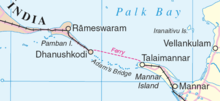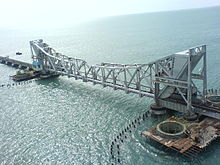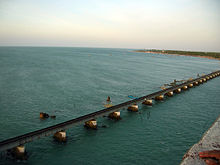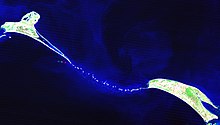Adam's Bridge!
Adam's Bridge!
In the 19th century, there were two prevalent theories explaining the structure. One considered it to be formed by a process of accretion and rising of the land, while the other surmised that it was formed by the breaking away of Sri Lanka from the Indian mainland. The friable calcerous ridges are broken into large rectangular blocks, which perhaps gave rise to the belief that the causeway is an artificial construction… which essentially consists of a series of parallel ledges of sandstone and conglomerates that are hard at the surface and grows coarse and soft as it descends to sandy banks.*** Is it not odd that a land bridge between India and Sri Lanka ended up becoming a 20 some odd mile link about 100 Ft in width for thousands of years?
Studies have variously described the structure as a chain of shoals, coral reefs, a ridge formed in the region owing to thinning of the earth’s crust, a double tombolo, a sand spit, or barrier islands. It has been reported that this bridge was formerly the world’s largest tombolo before it was split into a chain of shoals by the rise in mean sea level a few thousand years ago.
Based on satellite remote sensing data, but without actual field verification, the Marine and Water Resources Group of the Space Application Centre (SAC) of the Indian Space Research Organisation (ISRO) states that Adam’s Bridge comprises 103 small patch reefs lying in a linear pattern with reef crest (flattened, emergent – especially during low tides – or nearly emergent segment of a reef), sand cays (accumulations of loose coral sands and beach rock) and intermittent deep channels…
The geological process that gave rise to this structure has been attributed in one study to crustal down-warping, block faulting, and mantle plume activity while another theory attributes it to continuous sand deposition and the natural process of sedimentation leading to the formation of a chain of barrier islands related to rising sea levels…
Another study explains the origin the structure due to long-shore drifting currents which moved in an anticlockwise direction in the north and clockwise direction in the south of Rameswaram and Talaimannar. The sand was supposedly dumped in a linear pattern along the current shadow zone between Dhanushkodi and Talaimannar with later accumulation of corals over these linear sand bodies… another group of geologists propose crustal thinning theory, block faulting and a ridge formed in the region owing to thinning and asserts that development of this ridge augmented the coral growth in the region and in turn coral cover acted as a `sand trapper’.
Back in 2002, there were unsuccessful attempts by actual scientists to debunk the “ancient civilization” theory and inject some needed common sense and real science into the discussion. The Times of India had a story in 2002, noting:
Hanuman bridge is myth: ExpertsWell, science be damned when it interferes with your own personal mythology. The “man-made” bridge story re-emerged in 2013, with new NASA images of the tombolo, setting the pseudo-science dweebs into another frenzy of wild exaltation.
Eminent astrophysicist J V Narlikar, when contacted in Pune, said he had seen reports claiming about the mythical bridge, but there was no evidence to suggest that what had been located had links with the bridge mentioned in the Ramayana.
“There is no archaeological or literary evidence to support this claim,” eminent historian R S Sharma told The Times of India in Patna.
“The Ramayana itself is not that old. Nor had human habitation occurred 1.75 million years ago,” Sharma, an acknowledged authority on ancient Indian history, said.
See? they said, toldja-so. NASA says so. It’s proof of an ancient civilization. Claims that it was part of Atlantis and Lemuria quickly followed.
They’re all wrong in their claims. One hundred percent off the mark, every last one of them.
NASA said nothing of the sort, and has been trying to distance itself from any such ludicrous claims for more than a decade. But hey, on the internet, that’s the expected standard of truthiness.
NASA itself responded to the earlier claims (in 2002), allegedly by stating,
“Remote sensing images or photographs from orbit cannot provide direct information about the origin or age of a chain of islands, and certainly cannot determine whether humans were involved in producing any of the patterns seen,” said NASA official Mark Hess….NASA said the mysterious bridge was nothing more than a 30 km long, naturally-occurring chain of sandbanks called Adam’s bridge. Hess said his agency had been taking pictures of these shoals for years. Its images had never resulted in any scientific discovery in the area.
What remains about the water shows no evidence of construction. It looks like a typical sandbank. In fact, no proof of human construction has ever been found. Proponents of the bridge hypothesis have ways to explain this apparent anomaly, from erosion to environmental effects.
*** A maybe scenario?
NASA Images Find 1,750,000
Year Old Man-Made Bridge
The Hindustan Times
10-10-2
- WASHINGTON (PTI) -- The NASA Shuttle has imaged a mysterious ancient bridge between India and Sri Lanka, as mentioned in the Ramayana.
- The evidence, say experts matter-of-factly, is in the Digital Image Collection.
- The recently discovered bridge, currently named as Adam's Bridge and made of a chain of shoals, 30 km long, in the Palk Straits between India and Sri Lanka, reveals a mystery behind it.
- The bridge's unique curvature and composition by age reveals that it is man-made. Legend as well as Archeological studies reveal that the first signs of human inhabitants in Sri Lanka date back to the primitive age, about 1,750,000 years ago and the bridge's age is also almost equivalent.
http://www.hindustantimes.com/news/181_81164,0003.htm Courtesy NASA Digital Image Collection - Space images taken by NASA reveal a mysterious ancient bridge in the Palk Strait between India and Sri Lanka. The recently discovered bridge currently named as Adam laqno;s Bridge is made of chain of shoals, c.18 mi (30 km) long.
- The bridge laqno;s unique curvature and composition by age reveals that it is man made. The legends as well as Archaeological studies reveal that the first signs of human inhabitants in Sri Lanka date back to the a primitive age, about 1,750,000 years ago and the bridge laqno;s age is also almost equivalent.
- This information is a crucial aspect for an insight into the mysterious legend called Ramayana, which was supposed to have taken place in tredha yuga (more than 1,700,000 years ago).
- In this epic, there is a mentioning about a bridge, which was built between Rameshwaram (India) and Srilankan coast under the supervision of a dynamic and invincible figure called Rama who is supposed to be the incarnation of the supreme.
- This information may not be of much importance to the archeologists who are interested in exploring the origins of man, but it is sure to open the spiritual gates of the people of the world to have come to know an ancient history linked to the Indian mythology.
- *** Another view!
From Wikipedia, the free encyclopedia
Adam's bridge as seen from the air
The bridge is 30 kilometres (19 mi) long[3] and separates the Gulf of Mannar (southwest) from the Palk Strait (northeast). Some of the sandbanks are dry and the sea in the area is very shallow, being only 1 to 10 metres (3 to 30 ft) deep in places, which hinders navigation.[2][4][5] It was reportedly passable on foot up to the 15th century until storms deepened the channel: temple records seem to say that Adam’s Bridge was completely above sea level until it broke in a cyclone in 1480.[6]
The bridge was first mentioned in the ancient Indian Sanskrit epic Ramayana of Valmiki.[7] The name Rama's Bridge or Rama Setu (Sanskrit; setu: bridge) refers to the bridge built by the Vanara (ape men) army of Rama in Hindu theology with instructions from Nala,[8] which he used to reach Lanka and rescue his wife Sita from the Rakshasa king, Ravana.[7] The Ramayana attributes the building of this bridge to Rama in verse 2-22-76, naming it as Setubandhanam, a name that persists until today.[9]
The sea separating India and Sri Lanka is called Sethusamudram meaning "Sea of the Bridge". Maps prepared by a Dutch cartographer in 1747, available at the Thanjavur Saraswathi Mahal Library show this area as Ramancoil, a colloquial form of the Tamil Raman Kovil (or Rama's Temple).[10] Another map of Mughal India prepared by J. Rennel in 1788 retrieved from the same library called this area as "the area of the Rama Temple", referring to the temple dedicated to Rama at Rameswaram.[11] Many other maps in Schwartzberg's historical atlas[12][13] and other sources such as travel texts by Marco Polo call this area by various names such as Sethubandha and Sethubandha Rameswaram.[14][dead link][15][dead link][16][17]
The western world first encountered it in "historical works in the 9th century" by Ibn Khordadbeh in his Book of Roads and Kingdoms (c. 850), referring to it is Set Bandhai or "Bridge of the Sea".[18] Later, Alberuni described it. The earliest map that calls this area by the name Adam's bridge was prepared by a British cartographer in 1804.[2][7][19] Some early Islamic sources refer to a mountain in Sri Lanka as Adam's Peak, where Adam supposedly fell to earth, and describes Adam as crossing from Sri Lanka to India on what became known as Adam's Bridge.[20]
Location
Historical map of Adam's Bridge and environs, prior to the cyclone of 1964
The Pamban railway bridge, which connects Pamban Island with the Indian mainland, was constructed in 1914.
The problem in navigation exists because big ships cannot travel in the shallow waters of the Pamban channel. Dredging in this channel would cost more than dredging a channel in the Rama Setu area, where the waters are comparatively deep and lesser earth would have to be dredged. Hence, in 2005, the Government of India approved a multi-million dollar Sethusamudram Shipping Canal Project that aims to create a ship channel across the Palk Bay cutting across Rama Setu. Various organizations have opposed the project based on religious, economic and environmental grounds and have sought the implementation of one of the alternative alignments considered during the earlier stages of the discussion.
A ferry service linked Dhanushkodi in India with Talaimannar in Sri Lanka. The service was part of the Indo-Ceylon Railway service during the British Rule. One could buy a railway ticket from Chennai to Colombo, whereby people travelled by rail from Chennai to Pamban island, go by ferry to Talaimannar, and then go again by rail to Colombo.
In 1964, a cyclone completely destroyed Dhanushkodi, as a train was about to enter the station. The tracks and the pier were heavily damaged along the shores of Palk Bay and Palk Strait.[25] Dhanushkodi was not rebuilt and the train then finished its journey at Rameswaram. There was a small ferry service from there to Talaimannar, but it was suspended around 1982 because of the fighting between Sri Lankan government forces and the separatist LTTE.
Geological evolution
Landsat 7 Image of Adam's Bridge
Landsat 5 image of Adam's Bridge
According to V. Ram Mohan of the Centre of Natural Hazards and Disaster Studies of the University of Madras, "reconstruction of the geological evolution of the island chain is a challenging task and has to be carried out based on circumstantial evidence".[28] The lack of comprehensive field studies explains many of the uncertainties regarding the nature and origin of Adam's Bridge, which essentially consists of a series of parallel ledges of sandstone and conglomerates that are hard at the surface and grow coarse and soft as they descend to sandy banks.[citation needed]
Studies have variously described the structure as a chain of shoals, coral reefs, a ridge formed in the region owing to thinning of the earth's crust, a double tombolo,[29] a sand spit, or barrier islands. It has been reported that this bridge was formerly the world's largest tombolo before it was split into a chain of shoals by the rise in mean sea level a few thousand years ago.[30]
Based on satellite remote sensing data, but without actual field verification, the Marine and Water Resources Group of the Space Application Centre (SAC) of the Indian Space Research Organisation (ISRO) states that Adam's Bridge comprises 103 small patch reefs lying in a linear pattern with reef crest (flattened, emergent – especially during low tides – or nearly emergent segment of a reef), sand cays (accumulations of loose coral sands and beach rock) and intermittent deep channels. The coral reefs are designated by the different studies variously as ribbon and atoll reefs.
The geological process that gave rise to this structure has been attributed in one study to crustal downwarping, block faulting, and mantle plume activity [31] while another theory attributes it to continuous sand deposition and the natural process of sedimentation leading to the formation of a chain of barrier islands related to rising sea levels.[28] Another theory affirms that the origin and linearity of Adam's Bridge may be due to the old shoreline – implying that the two landmasses of India and Sri Lanka were once connected – from which shoreline coral reefs evolved.
Another study explains the origin the structure due to longshore drifting currents which moved in an anticlockwise direction in the north and clockwise direction in the south of Rameswaram and Talaimannar. The sand was supposedly dumped in a linear pattern along the current shadow zone between Dhanushkodi and Talaimannar with later accumulation of corals over these linear sand bodies.[citation needed] In a diametrically opposing view, another group of geologists propose crustal thinning theory, block faulting and a ridge formed in the region owing to thinning and asserts that development of this ridge augmented the coral growth in the region and in turn coral cover acted as a `sand trapper'.[citation needed]
The tombolo model affirms a constant sediment source and a strong unidirectional or bi-directional (monsoonal) longshore current.[citation needed] One study tentatively concludes that there is insufficient evidence to indicate eustatic emergence and that the raised reef in south India probably results from a local uplift.[32] Other studies also conclude that during periods of lowered sea level over the last 100,000 years, Adam's Bridge has provided an intermittent land connection between India and Sri Lanka, which according to famous ornithologists Sidney Dillon Ripley and Bruce Beehler supports the vicariance model for speciation in some birds of the Indian Subcontinent.[33]







No comments:
Post a Comment